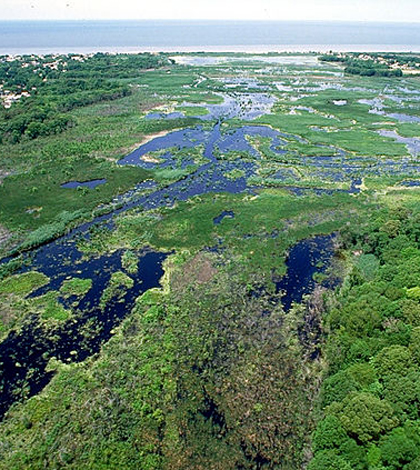Unseen wetland indicators: Study finds healthy brew of wetland microbes

Microorganisms play a vital role in wetland nutrient cycling. A group of University of Missouri researchers wants biologists and hydrologists to consider measure wetland microbes an indicator of habitat health.
In a study recently published in the journal Water Research, researchers Atreyee Sims, Yanyan Zhang, Shashikanth Gajaraj, Pamela Brown and Zhiqiang Hu detail a ratio between two groups of wetland microbes that indicates the health of a wetland based on the microbes’ reactions to nutrients entering the wetland.
They found that comparing concentrations of archaea to concentrations of bacteria can show if nutrient runoff is entering a wetland.
When a wetland is healthy with little man-made pollution, more archaea live in the sediment and water. When ammonia enters wetlands, the bacteria feast and their population grows, indicating pollution in the wetland.
The researchers found that genetic traits are identifiable for the organisms, which makes them measurable, said Zhiqiang Hu, a MU civil and environmental engineering professor. “We can determine these organisms individually and then we can calculate the ammonia-oxidizing archaea and ammonia-oxidizing bacteria,” said Hu.
MU researchers used polymerase chain reaction tests, common in many laboratories, to measure microbes. The test replicates DNA sequences that can be examined for genetic characteristics that occur in each type of microbe.
Hu said the availability of the PCR test means many laboratories have the capability to measure the microbes. “This technology is becoming more and more feasible for organizations and state funded laboratories,” said Hu.

Zhiqiang Hu, MU civil and environmental engineering professor
Both microbes in the study oxidize ammonia, which plays a key role in cycling the nutrient through a wetland. In pristine wetlands with no excess nutrient loading, ammonia-oxidizing archaea live in larger numbers. However, when excess ammonia enters wetlands, the bacteria become more prevalent. They feed on the ammonia and their populations grow.
Study authors surmised that healthy wetland has a higher ratio of ammonia oxidizing archaea to ammonia oxidizing bacteria. The result means little nutrient runoff is entering the wetland from human activity.
For their study, MU researchers collected soil and water samples at three different wetlands. They collected water quality data on pH, dissolved oxygen, temperature and phosphorus concentrations, while sampling.
They found that archaea are especially prevalent in low dissolved oxygen environments with little nutrients present. When ammonia is present, bacteria populations increase.
A benefit to using microorganisms as indicators is their function as a high resolution measurement. The bacteria are fast reacting organisms. That gives the ratio more timeliness than other standardized indicators for wetland health and more sensitivity to change.
Information on the microbes has been emerging from wetland scientists across the U.S. during the last 15 years. The MU researchers say now is the time to start acting on the research.
That’s why Hu is making the case to institute the measure as part of the U.S. Environmental Protection Agency’s list of indicators for measuring water quality.
Given the strong relationship between microorganisms and wetland pollutants, Hu said people with access to the necessary equipment should use the measurements. “It’s time for the scientists to think about the new approach in our paper,” Hu said.
Top image: Wetlands on Cape May, N.J. (Credit: Anthony Bley, U.S. Army Corps of Engineers)




0 comments